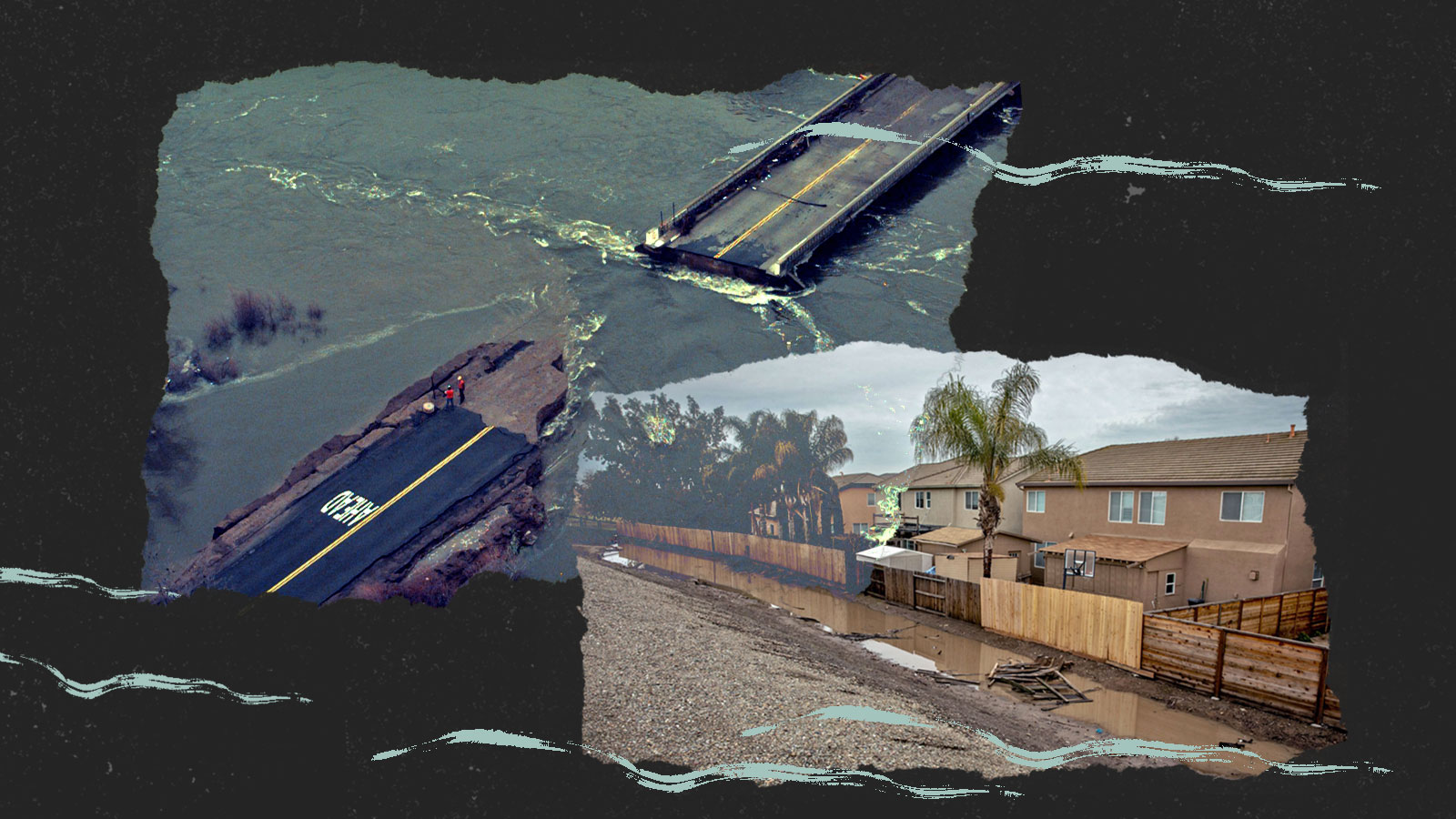In early 1862, a storm of biblical proportions struck California, dropping more than 120 inches of rain and snow on the state over two months. The entire state flooded, but nowhere was the deluge worse than in the Central Valley, a gash of fertile land that runs down the middle of the state between two mountain ranges. In the spring, as melting snow mixed with torrential rain, the valley transformed into “a perfect sea,” as one observer put it, vanishing beneath 30 feet of water that poured from the Sacramento and San Joaquin Rivers. People rowed through town streets on canoes. A quarter of all the cows in the state drowned. It took months for the water to drain out.
More than 150 years later, climate scientists say the state is due for a repeat of that massive storm. A growing body of research has found that global warming is increasing the likelihood of a monster storm that could inundate the Central Valley once again, causing what one study from UCLA and the National Atmospheric Center called “historically unprecedented surface runoff” in the region. Not only would this runoff destroy thousands of homes, it would also ravage a region that serves as the nation’s foremost agricultural breadbasket. The study found that global warming has already increased the likelihood of such a storm by 234 percent.
In the crosshairs of that storm is the Stockton metropolitan area, which sits at the mouth of the San Joaquin River. Stockton and its neighboring suburbs are home to almost 800,000 people, and they rank among the most diverse places in the country — as well as some of the most economically distressed places in California. Thanks to decades of disinvestment, the city’s only flood protection comes from decades-old, leak-prone levees. If a major rain event caused enough runoff to surge down the mountains and northward along the San Joaquin, it could burst through those levees, inundating the city and flooding tens of thousands of homes. One federal study found that much of Stockton would vanish beneath 10 to 12 feet of water, and floods in the lowest-lying areas could be twice as deep. The result would be a humanitarian disaster just as costly and as deadly as Hurricane Katrina.
The “atmospheric river” rainstorms that rolled into California from the Pacific Ocean this month have underscored the Golden State’s vulnerability to floods, but experts insist that the destruction of Stockton isn’t inevitable. As is the case in flood-prone communities across the country, local officials know how to manage water on the San Joaquin River, but they’ve struggled to obtain funding for Stockton and other disadvantaged cities along the waterway. Even as California lawmakers have plowed money into drought response in recent years, they’ve left flood measures by the wayside, and the federal government has also been slow to fund major improvements.
“Areas like Stockton that don’t have political clout … often get bypassed terms of consideration for funding,” said Mike Machado, a former California state senator who has long advocated for better flood management in the Central Valley. “Even if any funding is available, Stockton is usually at the bottom of the list.”
Even as Stockton’s infrastructure decays, the city’s flood risk is only increasing thanks to climate change, which will cause more severe rains in the San Joaquin Valley and further stress the city’s levees. The city has grown at a rapid pace over the past two decades, but state and local officials have been more focused on protecting local agricultural irrigators from drought than on protecting the city’s residents from flooding. When the next big storm hits, it is Stockton’s communities of color, which make up more than 80 percent of the city’s population, that will see the worst of the damage.
“We are at the bottom of the bowl,” said Barbara Barrigan-Parrilla, the executive director of Restore the Delta, a Stockton-based environmental nonprofit. “We’re the drain. And they don’t value us.”
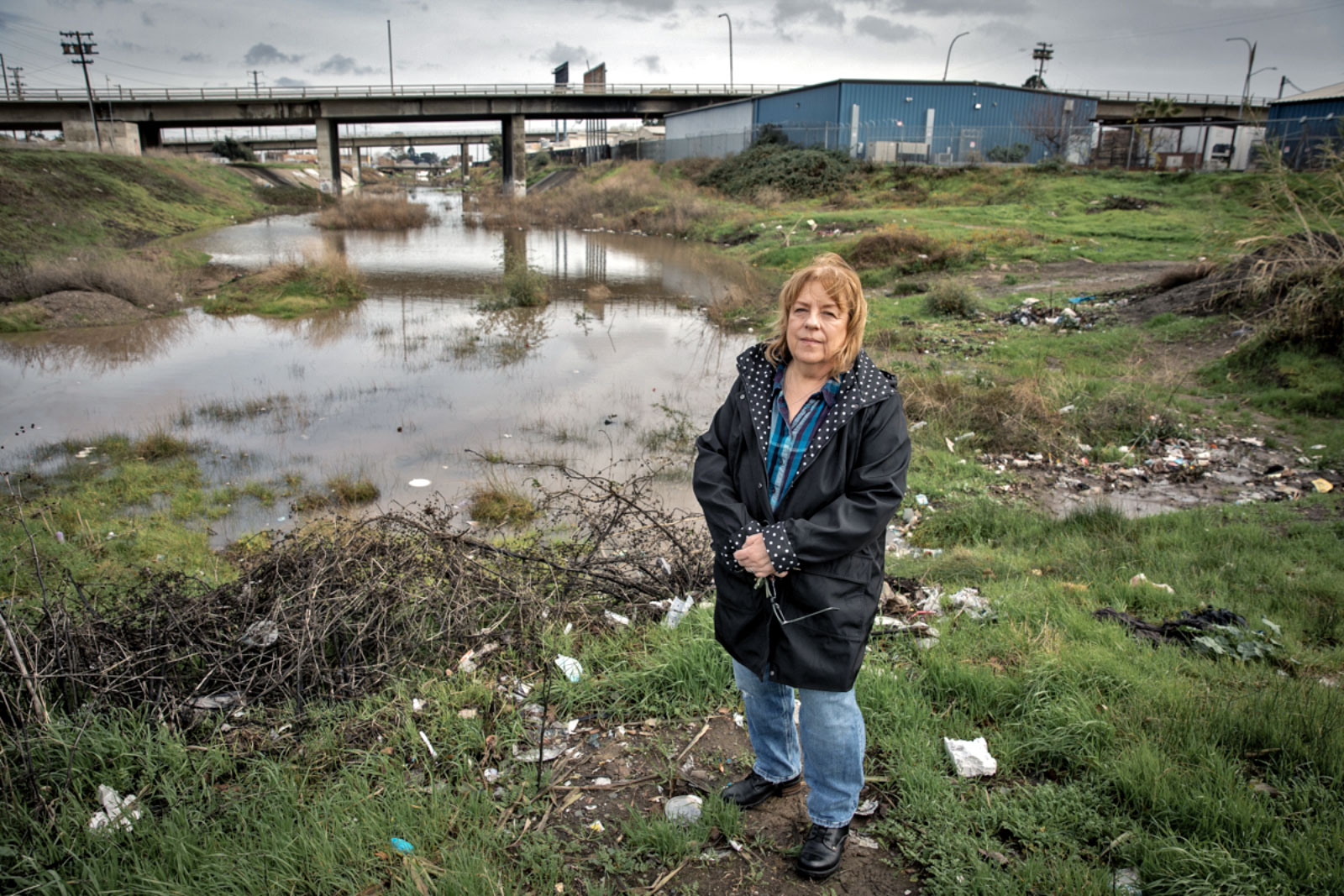

The Central Valley’s flood protection system has never been equal. During the nineteenth and early twentieth centuries, farmers and ranchers constructed a hodgepodge of levees along rivers like the San Joaquin, piling sand only high enough so that water would flood someone else’s land rather than their own. The levees were owned and maintained by local districts, rather than any centralized governing body, so wealthier areas ended up with stronger defenses.
As the region’s flood protection system expanded, the San Joaquin region fell behind. To protect the state capital of Sacramento in the 1920s, the federal Army Corps of Engineers built a diversion system called the Yolo Bypass that funnels water away from the city, but Stockton never saw any similar investment. Local authorities couldn’t raise as much money to bolster levees as their counterparts around Sacramento, and money from the state and the federal government never filled the gap.
This is in part because lawmakers have overlooked Stockton’s vulnerable populations, according to Jane Dolan, president of the Central Valley Flood Protection Board, a state agency that oversees flood management. But Dolan says the disparity also exists because leaders along the San Joaquin River have long tended to focus more on securing water for agricultural irrigation than on managing the rivers, which has made it hard to secure momentum for big flood improvements.
“They don’t have that consensus about managing floodwaters and allowing space for the river,” she told Grist. “Politicians from city councils to Congress are all focused on water supply.”
Not only does the San Joaquin have the shoddiest flood protection infrastructure, but it also faces the greatest degree of risk from climate-fueled storms. Both the UCLA study and a separate study by Dolan’s organization found that warmer climates will increase runoff in the San Joaquin watershed by more than they will in the Sacramento watershed — in large part because higher temperatures will cause what used to be snow to fall as rain instead. Furthermore, Stockton faces flood risk from all sides: Not only does the San Joaquin River flood during rain events, but the Calaveras River on the city’s north side does as well. Water from the Pacific Ocean could even flood the city from the west during high tides as it pushes across a long flat expanse known as the Delta.
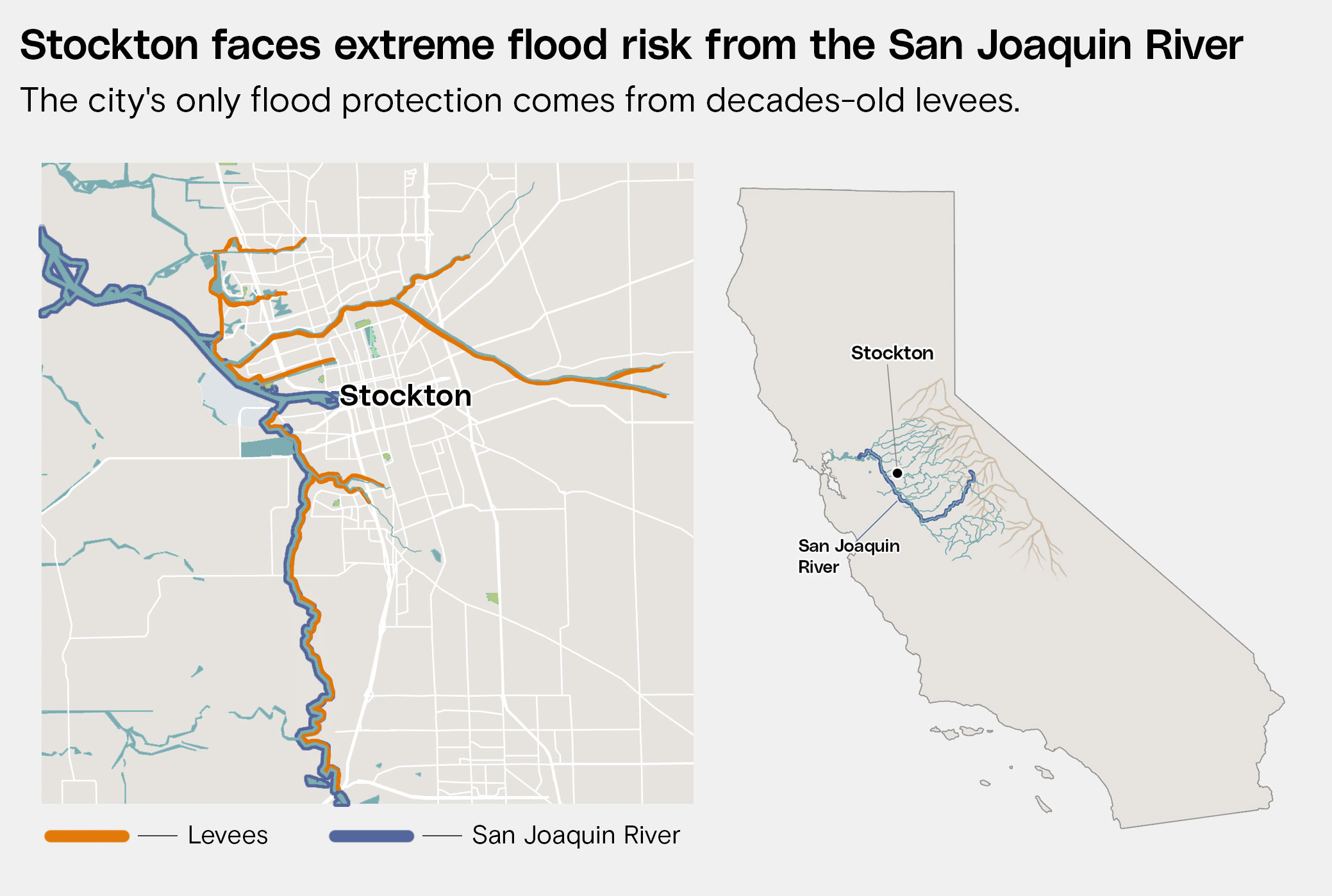
“The San Joaquin Valley is the most vulnerable to intense floods, because the climate science is clear that there will be less snow there, and more rain,” said Dolan. The river’s levee system was designed for a long snowmelt, not an all-at-once deluge, she added, which means that bigger atmospheric river storms are all but certain to overwhelm it.

Despite this risk, Stockton has expanded rapidly over the past few decades. Not only has the city grown into a hub for the valley’s all-important agricultural industry, its relatively cheap land and proximity to the populous San Francisco Bay Area has made it a boom site for new warehouses and packing facilities owned by companies like Amazon. During the last housing boom, developers built subdivision after subdivision along the San Joaquin River to house new arrivals, relying on the decades-old levees to protect them.
As it has grown, Stockton has become one of the most diverse cities in the country, with substantial Mexican, Filipino, Chinese, Cambodian, and African American communities. Many of these have poverty rates that are much higher than the state average, and they also face severe environmental justice risks: The neighborhoods of southwest Stockton are surrounded by freeways, factories, and port infrastructure, making them among the most exposed in the state to soot and diesel pollution.
“Because of redlining and historical discrimination, we have a lot of people of color, and people are at the lower end of the socioeconomic scale, right behind these levees,” said Barrigan-Parrilla.
Mary Gómez is a 50-year resident of the Conway Houses, a low-income housing development on the south side of Stockton. The development sits just feet from the Walker Slough, a small waterway that drains off the San Joaquin River. Gómez, 70, told Grist that she worries about flooding from the river frequently and feels the area doesn’t get enough attention from city officials.
“It’s because they think we’re ghetto,” she said. “We are worried, because what if it floods [upstream] and we don’t hear about it, and they don’t tell us? Who’s gonna come and help us, or get us out? There’s so many of us that don’t have cars, that have kids.”
Gómez said she also worries about whether the neighborhood’s elderly and disabled could get out in time. The last time it came close to flooding, she said, her neighbors told her that she should protect her house with sandbags.
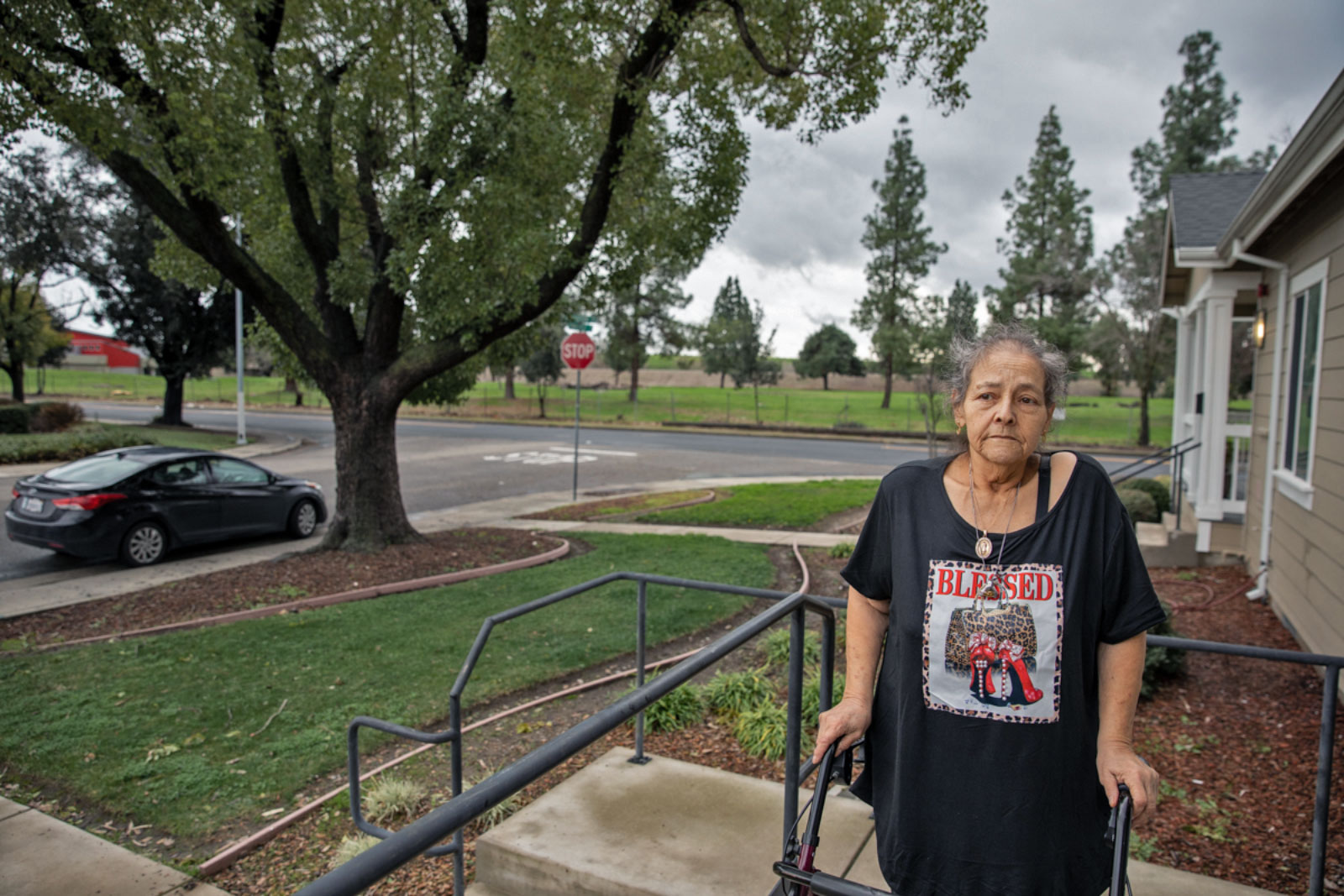

For decades, local officials have tried to secure state and federal money for flood protection projects, but progress has been slow as the risk has only increased. Way back in 1995, when the federal government was weighing whether to deem the levees in north and central Stockton inadequate, the area’s flood control authority had to self-finance levee improvements through tax assessments on local property owners — a costly proposition in a relatively low-income area with a meager tax base.
“We have a severely disadvantaged community,” said Chris Elias, director of the San Joaquin Area Flood Control Agency, the authority that manages the region’s levees. “We cannot impose too much burden on them — they’ve borne too much burden already. So we explore those other funding avenues. But just like everything else, we are competing with a whole bunch of other priorities that the state has.”
The state has passed a number of bond measures over the years to fund flood improvements, but local officials say Stockton hasn’t received a fair share of that money. For every five dollars spent in Sacramento, Elias said, Stockton has seen only one dollar of spending. He said that’s in part because the state money went to projects that were already “shovel-ready,” and Stockton-area officials lacked the resources to design projects and apply for grants.
Federal help has also been hard to come by. In 2010 the Army Corps of Engineers finally decreed that many of Stockton’s levees were inadequate and that much of the city was vulnerable to massive flooding. The agency spent the next seven years studying the problem, but in the end it proposed only a partial solution. While the Corps agreed to pursue a $1.3 billion suite of levee repair projects in north and central Stockton, it punted on a proposal to bolster the levees in south Stockton and two nearby suburbs — the parts of the area that faced the greatest economic hardship and the greatest exposure to flooding on the San Joaquin. The agency’s argument was that repairing levees in those areas would encourage new development, thus increasing the risk. It has since agreed to revisit that decision, but in the meantime tens of thousands residents in the area are still just as vulnerable to flooding as they were a decade ago.
In response to questions from Grist, a spokesperson from the Corps’s Sacramento district said that the agency had been constrained by an executive order that limits federal investment in flood-prone areas.
“Deferring decisions regarding the area to the south of Stockton … allowed [the Corps] and its state and local partners to prevent further delays in gaining congressional authorization to protect Stockton from catastrophic flooding,” said the spokesperson. He added that the agency plans to “reexamine federal interest in the [area] and identify potential flood risk management and ecosystem restoration opportunities.… However, the outcomes of that study are not yet determined.”
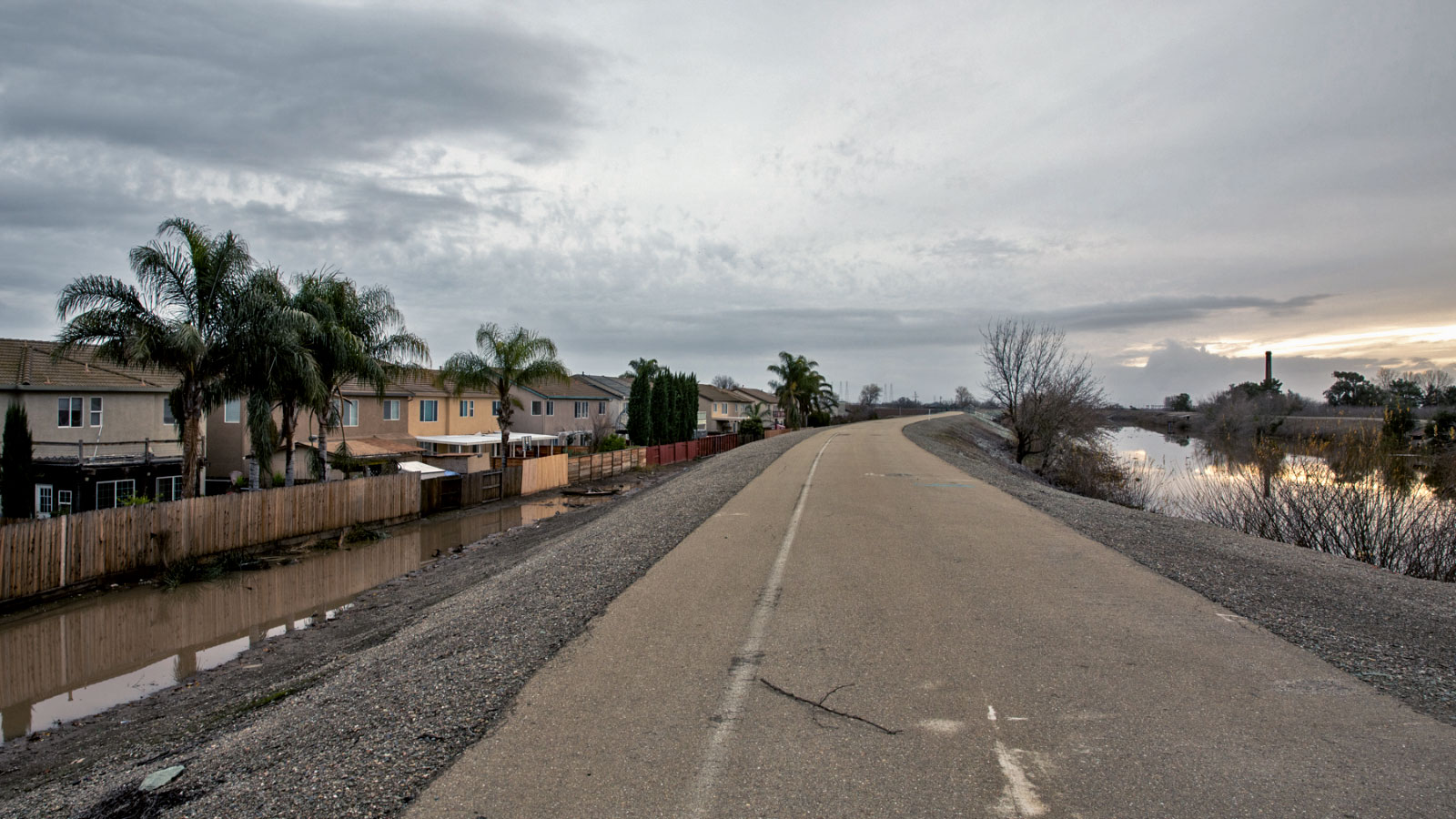
Another problem is that levees alone aren’t sufficient as a flood management strategy. No matter how high you build a levee, a future flood can always overtop it, and the consequences when a levee breaks are often worse than they would have been if the levee hadn’t been there in the first place, as was demonstrated in New Orleans after Katrina. Many local officials believe that, instead of just building more levees, the state should give flood waters another place to go by creating natural floodplains out of conserved land. That’s what the state did near Sacramento with the Yolo Bypass.
“You can build a levee stronger and better, but it’s still vulnerable to breaking,” said John Cain, director of conservation at River Partners, a nonprofit that advocates for such floodplain restoration projects. “If you want to have more resiliency in the system, you literally need more room.”
Cain’s organization has put this approach to the test about 20 miles upstream on the San Joaquin by purchasing unused land and converting it into a natural floodplain. During big rain events, water flowing downstream on the river can spill onto the reserved land instead of flowing toward Stockton, taking pressure off the city’s levees. Officials in Stockton have been trying to replicate this strategy closer to the city by creating a wide flood bypass called Paradise Cut on reserved farmland. The project would reduce the depth of potential flooding in the Stockton area by as much as two feet, but the Army Corps rejected that project back in 2018 as well, questioning whether it would pass a cost-benefit analysis.
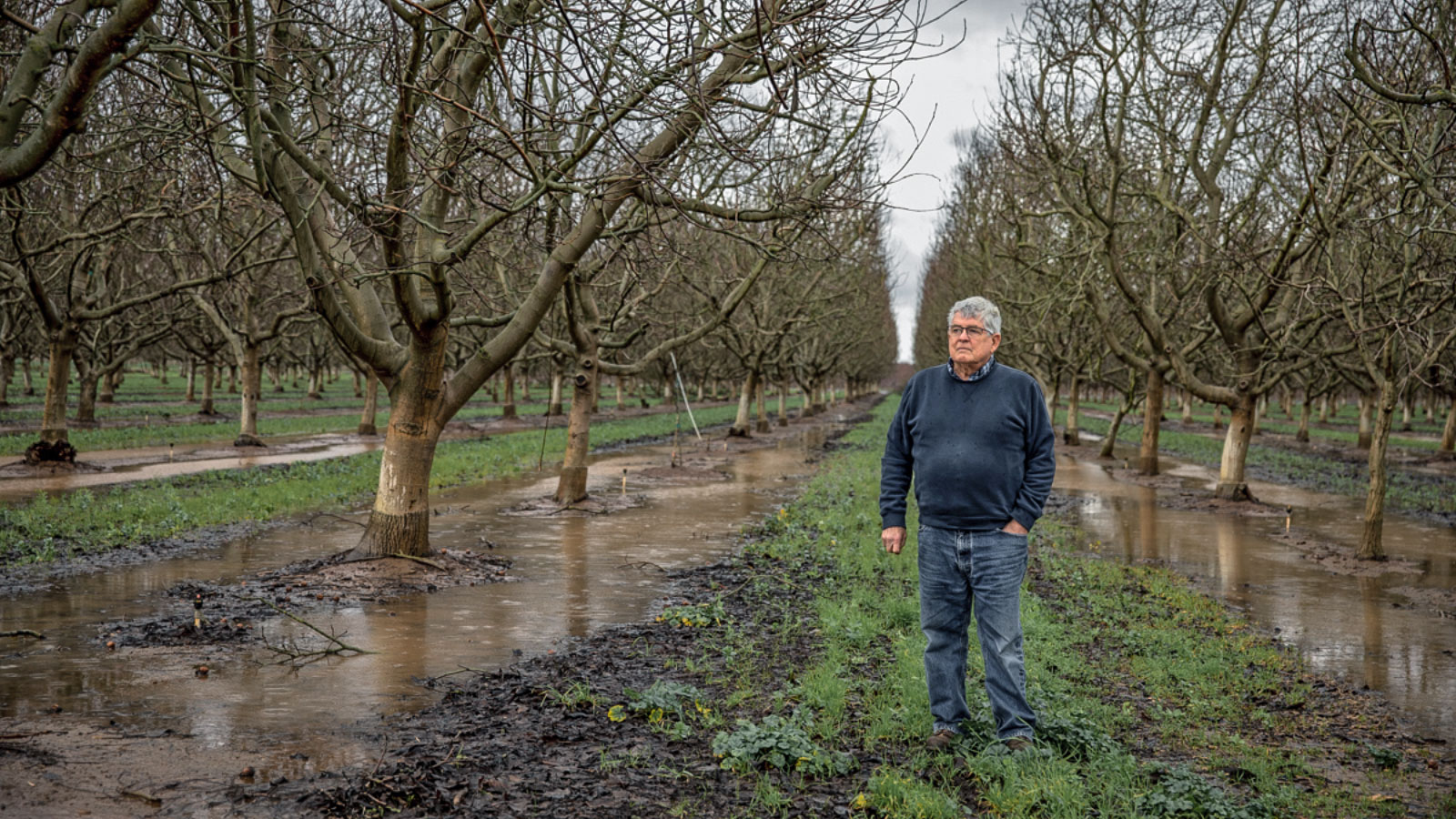
Meanwhile, state funding for flood management has all but dried up even as lawmakers plow billions into drought relief, leaving Stockton dependent on the slow-moving Army Corps of Engineers for project money. Governor Gavin Newsom’s proposed budget for the coming year proposes to spend just $135 million on flood management, less than a third of what Dolan’s organization says the state should be spending every year. The proposed budget also seeks to claw back $40 million that was allocated in last year’s budget for floodplain restoration along the San Joaquin River.
Newsom’s office did not respond to a request for comment in time for publication.
Machado, the former state senator, hopes this month’s storms will bring some attention to flood risk in the state, but he’s not sure the attention will translate into new spending.
“After a flood, the holes get plugged, the sun comes out, and they forget,” he told Grist. “All of a sudden you’re in a drought period, or an extended period with no imminent threat of a flood, and it becomes a backburner issue.”
Gabriela Aoun contributed reporting to this story.

